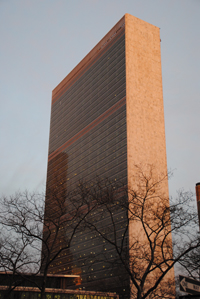
As the United Nations marks its 70th anniversary, DAVID ADAMS takes a look at what it’s all about…
This year marks 70 years since the United Nations was founded. So here we delve into some of its history and facts and figures which go some way to explaining what the global body is all about…

UN headquarters in New York City. PICTURE: David Adams
• The first international organisations were aimed at encouraging cooperation on specific issues – such as the International Telecommunication Union founded in 1865 as the International Telegraph Union (and now a UN agency) – but the true forerunner of the UN was the League of Nations, established after World War I in 1919 under the Treaty of Versailles. It ceased its existence after failing to prevent World War II.
• The term “United Nations” was coined by US President Franklin D Roosevelt and was first used in the Declaration by United Nations of 1st January, 1942, when, during World War II, representatives of 26 nations pledged to continue fighting against Nazi Germany and the Axis powers.
• The United Nations Charter was signed on 26th June, 1945, by representatives of 50 countries – including the UK, US, China and Russia – at a meeting in San Francisco attended by 3,500 delegates, advisors and staff as well as more than 2,500 media representatives. Poland, which wasn’t represented at the meeting, became the 51st signatory shortly after.
• The United Nations formally came into existence on 24th October, 1945, after the charter had been ratified by the majority of signatories. The day is now celebrated each year as United Nations Day.
• The UN has four main purposes: “to keep peace throughout the world”; “to develop friendly relations among nations”; “to help nations work together to improve the lives of poor people, to conquer hunger, disease and illiteracy, and to encourage respect for each other’s rights and freedoms”; and, “to be a centre for harmonising the actions of nations to achieve these goals”.
• The first secretary general of the United Nations was Trygve Lie, a former Foreign Minister of Norway. There have only been eight people in that role including Dag Hammarskjold, who died in a plane crash in 1961 on a peace mission in the Congo, becoming the only secretary general to die in office. To date, each of the secretaries general have come from a different country – Lie (Norway), Hammarskjold (Sweden), U Thant (Myanmar), Kurt Waldheim (Austria), Javier Perez de Cuellar (Peru), Boutros Boutros-Ghali (Egypt), Kofi A Annan (Ghana), and the current secretary general, Ban Ki-moon (South Korea).
• Today, the United Nations boast 193 member states with South Sudan the latest country to join (in 2011). The Holy See (Vatican) and State of Palestine are both non-member states which are Permanent Observers. Those few countries which aren’t members include Kosovo and Taiwan.
• The UN’s first resolution, adopted by the General Assembly on 24th January,1946, was entitled ‘Establishment of a Commission to Deal with the Problems Raised by the Discovery of Atomic Energy’. Other key documents adopted by the General Assembly over the years have included the Universal Declaration of Human Rights (1948), the United Nations Emergency Force resolution establishing the first peacekeeping force (1956), the Treaty on the Non-Proliferation of Nuclear Weapons (1968) and, a resolution creating the Intergovernmental Panel on Climate Change (1988).
• As well as the UN itself, the “UN family” includes more than 30 affiliated programmes, funds, and specialised agencies, including everything from UNHCR (the office of the United Nations High Commissioner for Refugees) to UNESCO (the United Nations Educational, Scientific and Cultural Organization) and UNICEF (the United Nations Children’s Fund) as well as the World Bank and World Health Organization (WHO).
• Over its 70 year history the United Nations has had many successes – and failures (although it’s incorrect to blame the UN solely for failures such as the Rwandan Genocide of 1994 – the body’s actions, remember, are largely dictated by the member states). That said, the organisation has been credited with negotiating more than 170 peace settlements. In addition, the UN has been involved in some 69 peacekeeping and observer missions. The organisation currently has 16 peacekeeping missions around the world involving 125,000 people from 120 countries.
Sources: UN






